18 Types of Black Birds in Washington (With Pictures)
Last Updated on
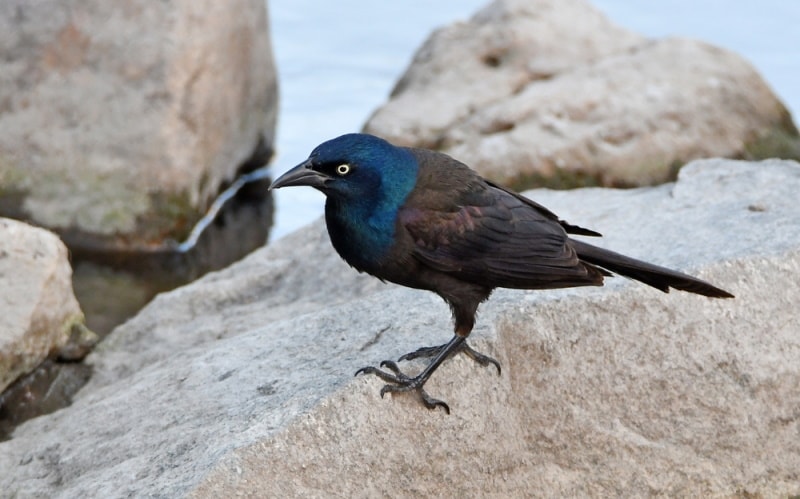
Washington State is home to a variety of wild animals due to its densely forested areas, expansive lakes, and mountainous regions. Bird watchers can find all sorts of birds throughout the Evergreen State, including at feeders in their backyards.
Black birds, despite their name, are among the most vibrantly colored birds that you can find in your garden. Strangely enough, not all black birds are considered part of the blackbird family, so we included blackbirds and birds with black feathers on this list.
Here, you will be introduced to the types of black birds that you can find in Washington State, both native and rare visitors. We hope that it’ll help you identify a few of the vibrant birds in your backyard!

The 11 Native Visitors
1. American Crow
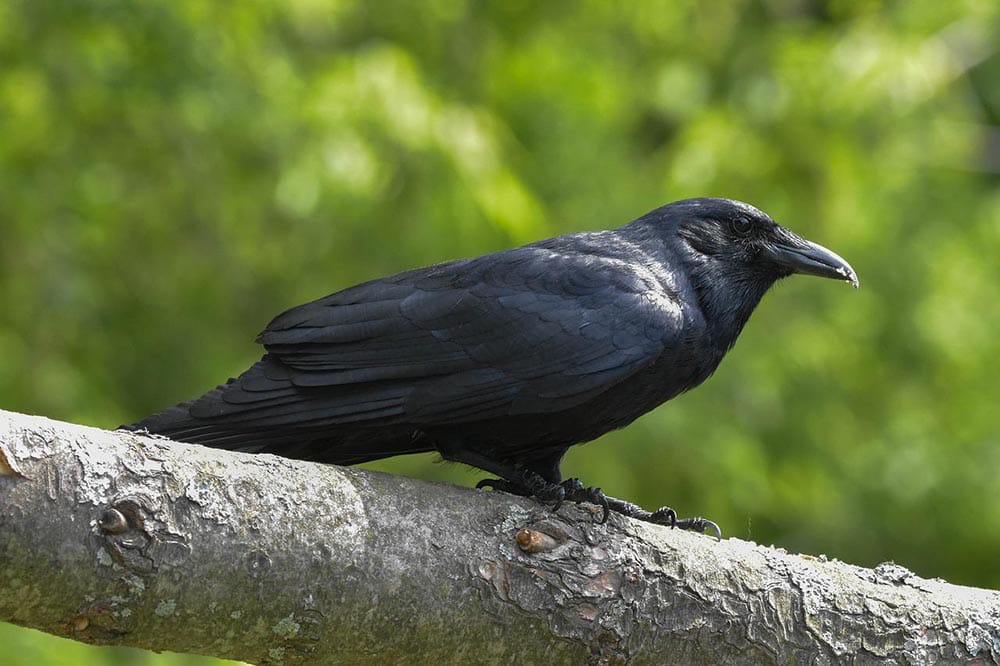
| Scientific Name | Corvus brachyrhynchos |
| Wingspan | 33.5–39.4 inches |
| Size | 15.8–20.9 inches |
Commonly confused with the Raven, the American Crow is probably one of the first birds that come to mind when you think of black birds.1 This bird is a frequent sight in rural and urban areas. The Crow is distinguishable from the Raven due to their smaller size and the rounded or square shape of their tail.
As part of the Corvidae family, they’re not technically classed as blackbirds despite their dark plumage. However, the American Crow makes this list due to their iconic presence throughout the U.S.A., including Washington State.
2. Bobolink

| Scientific Name | Dolichonyx oryzivorus |
| Wingspan | 6 inches |
| Size | 9–8.3 inches |
Found in Washington during the breeding season, the Bobolink is easy to recognize for its black-and-white plumage and the yellow patch on the back of its head.2 Compared to the bright coloring of the breeding males, the females, and non-breeding males are much subtler brown and yellow.
Unlike many other birds that don’t migrate far, the Bobolink is one of the species that have an impressive migration. While they breed in the northern U.S.A., they migrate to and from southern South America each year.
3. Brewer’s Blackbird
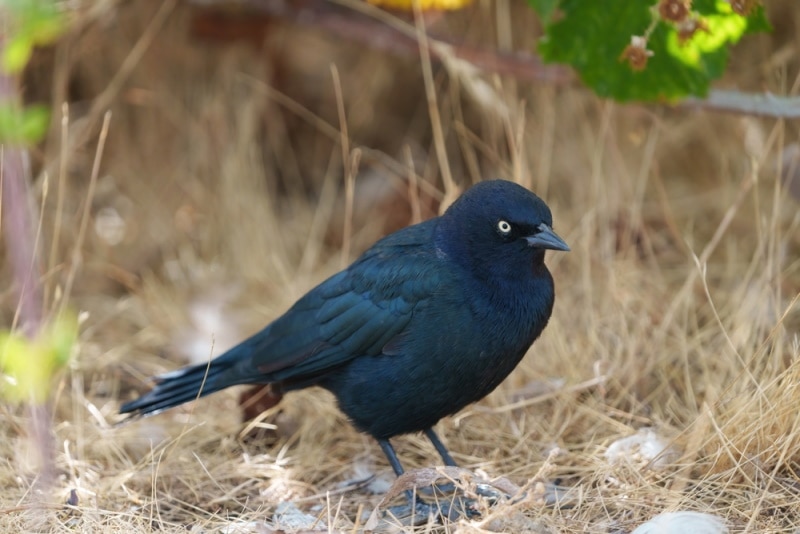
| Scientific Name | Euphagus cyanocephalus |
| Wingspan | 6 inches |
| Size | 9–9.8 inches |
A familiar sight in open grasslands and towns throughout the year in Washington, the male Brewer’s Blackbird is distinguishable from the American Crow by their bright yellow eyes and midnight-blue and metallic-green feathers.3 The females are plain brown and lack the bright yellow eye of the male.
Although they’re often seen as a menace to agriculture, the Brewer’s Blackbird is more fond of eating insects than they are grains — although they do eat grains too. Their insect-based diet often makes them a friend of farmers rather than a pest to crops.
4. Brown-headed Cowbird
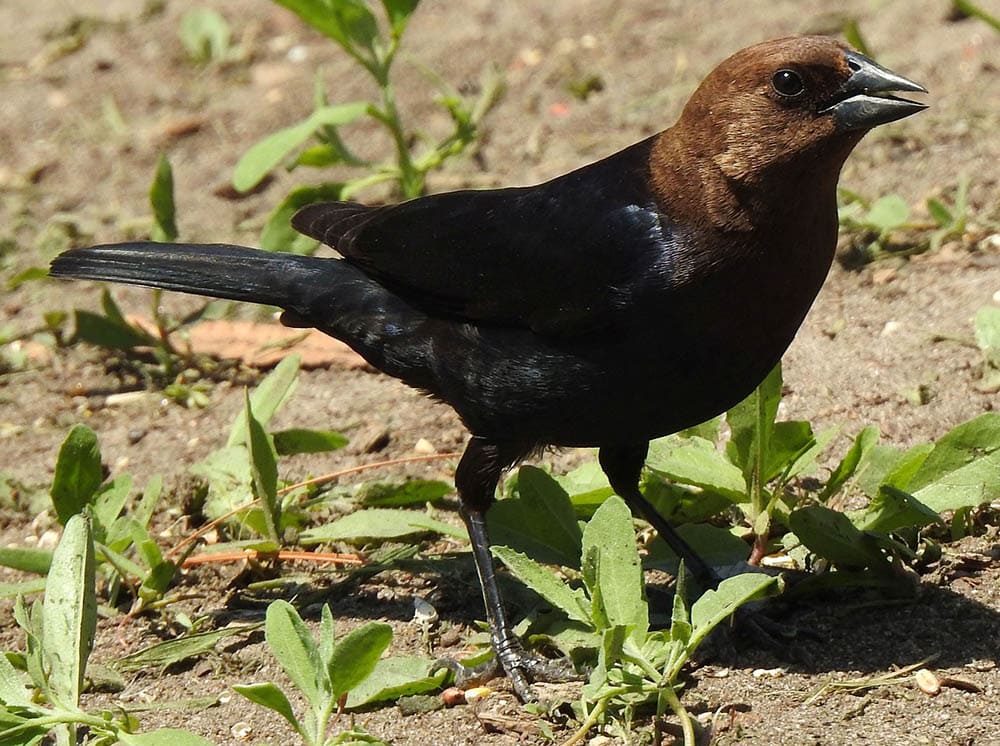
| Scientific Name | Molothrus ater |
| Wingspan | 6–15 inches |
| Size | 3–8.7 inches |
The Brown-headed Cowbird can be found in different areas of Washington depending on the time of year. They’re a common sight along the coast and often migrate into the central and eastern parts of the state for the breeding season. With a mostly black plumage and brown head, the males are among the easiest black birds to recognize by new bird watchers.
Their habit of laying their eggs in the nests of other birds — often at the cost of some of the host’s brood — makes them one of the most common “brood parasites” in the U.S.A.
5. Bullock’s Oriole

| Scientific Name | Icterus bullockii |
| Wingspan | 2 inches |
| Size | 7–7.5 inches |
Similar in appearance to the Baltimore Oriole, the Bullock’s Oriole can be recognized by their yellow faces, black stripe through the eye, and chin patch. The Bullock’s reddish-orange breast and striking white markings on their wings make them an eye-catching sight in woodland areas.
They’re most commonly found in eastern Washington during the breeding season, and they’ll forage or make their nests while hanging upside down from tree branches. While they won’t eat seeds from the feeder in your yard, they do drink sugar water from hummingbird feeders, provided that they have somewhere to perch.
6. Common Raven
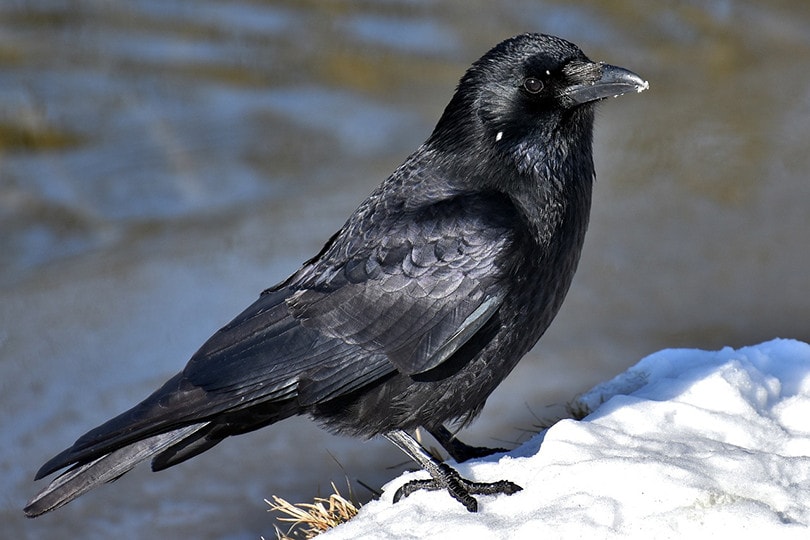
| Scientific Name | Corvus corax |
| Wingspan | 7–46.5 inches |
| Size | 1–27.2 inches |
Despite how often they’re mistaken for the American Crow and vice versa, the Common Raven is one of the most recognizable black birds in the U.S.A. Distinguished by the wedge shape of their tail, their ruffled neck feathers, and the size of their beak, the Raven is a member of the Corvidae family rather than a blackbird. Their pitch-black feathers and presence in Washington throughout the year make them a firm favorite for this list.
Acrobatic and highly intelligent, the Common Raven has been known to investigate gunshots in search of a carcass while ignoring other loud noises. They’re also capable of mimicking other bird species’ calls or human words.
7. European Starling
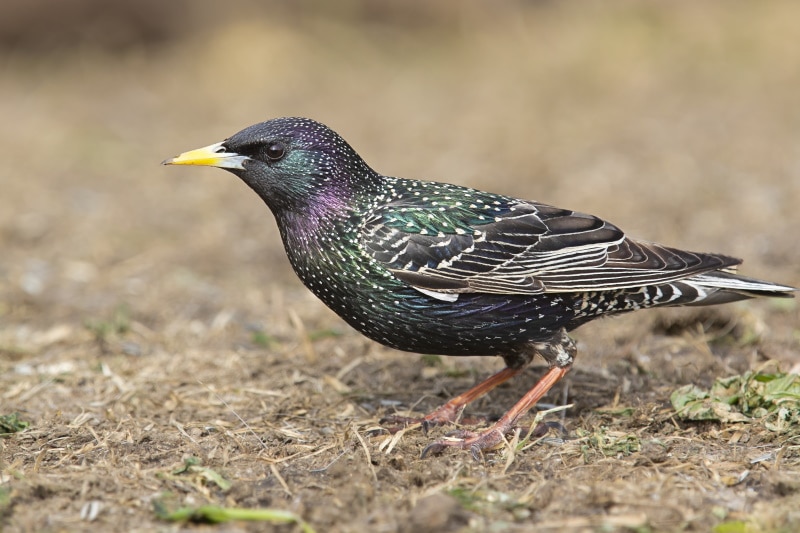
| Scientific Name | Sturnus vulgaris |
| Wingspan | 2–15.8 inches |
| Size | 9–9.1 inches |
Another recognizable black bird that isn’t technically a member of the blackbird (Icteridae) family is the European Starling. They’re also not originally native to the U.S.A. and were introduced in the 19th century by fans of Shakespeare.
While young males are mostly brown with metallic-green and -blue feathering, breeding males are much darker but no less vibrantly colored. They have black, purple, green, blue, and white markings and are often a striking sight at bird feeders.
8. Red-Winged Blackbird
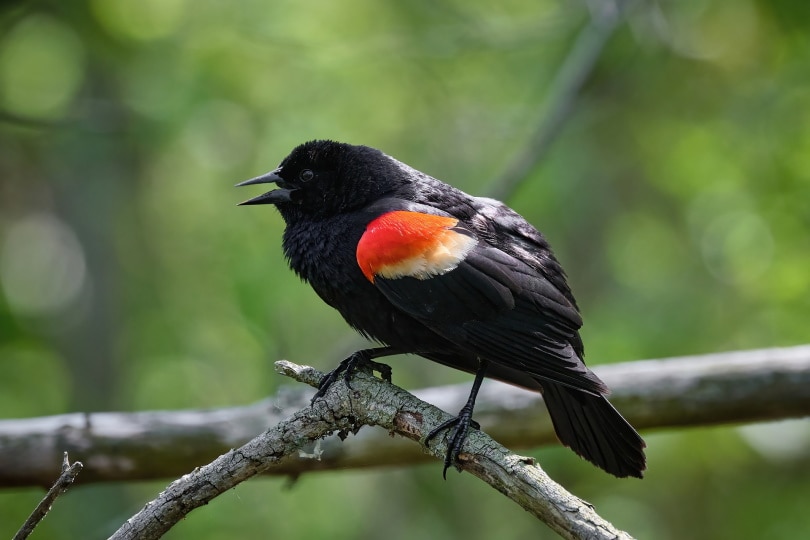
| Scientific Name | Agelaius phoeniceus |
| Wingspan | 2–15.8 inches |
| Size | 7–9.1 inches |
Easily distinguished by the bright red and yellow patch on their wings — and the subtler red on the females — the Red-Winged Blackbird is native to Washington throughout the year. Except for their bright wing patches, the males are completely black, while the females are similar in appearance to sparrows, with a more mottled brown-and-white plumage.
As one of the most familiar birds throughout the U.S.A., the Red-Winged Blackbird population is widespread. They can be found in most of Canada during the breeding season and even in parts of Mexico throughout the year.
9. Tricolored Blackbird

| Scientific Name | Agelaius tricolor |
| Wingspan | 2–13 inches |
| Size | 1–9.4 inches |
Nearly identical to the Red-Winged Blackbird but with a white patch instead of a yellow one, the Tricolored Blackbird is a rare sight throughout the western states. The females are a mottled brown, while the nonbreeding males are a grayish black, with an orange stripe on their wings.
They’re found in Washington, Oregon, and California throughout the year. However, they’re an endangered species due to the loss of wetlands, so you’re not likely to spot one even if you’re in the right part of Washington. They’re also easy to misidentify as the Red-Winged Blackbird due to their similar coloring.
10. Western Meadowlark
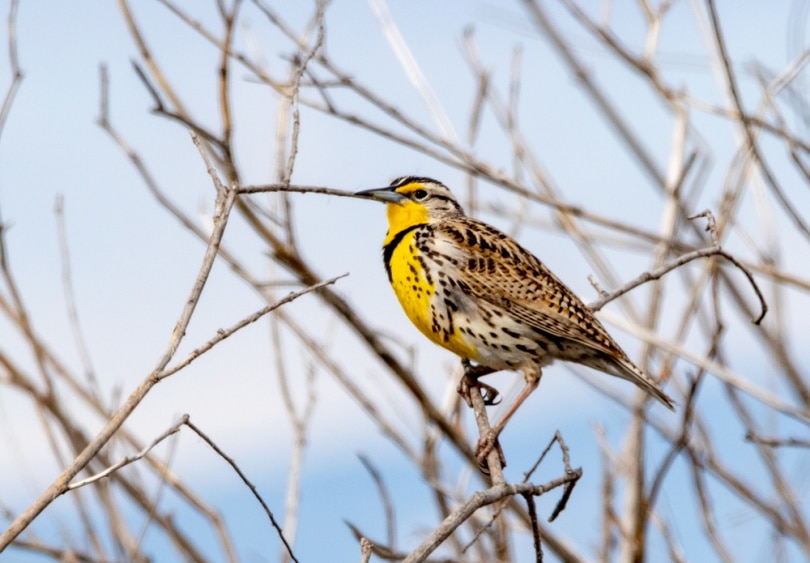
| Scientific Name | Sturnella neglecta |
| Wingspan | 1 inches |
| Size | 3–10.2 inches |
Although the Western Meadowlark doesn’t look like a typical blackbird, they are part of the same family and have striking black markings to show for it. While they’re mostly brown with a yellow chest, they have a bold black stripe behind their eyes and a V-shaped band on their breast.
You can find them in western and central Washington throughout the year and on the eastern side of the state during the breeding season. They favor grasslands, meadows, and the edges of marshes.
11. Yellow-Headed Blackbird
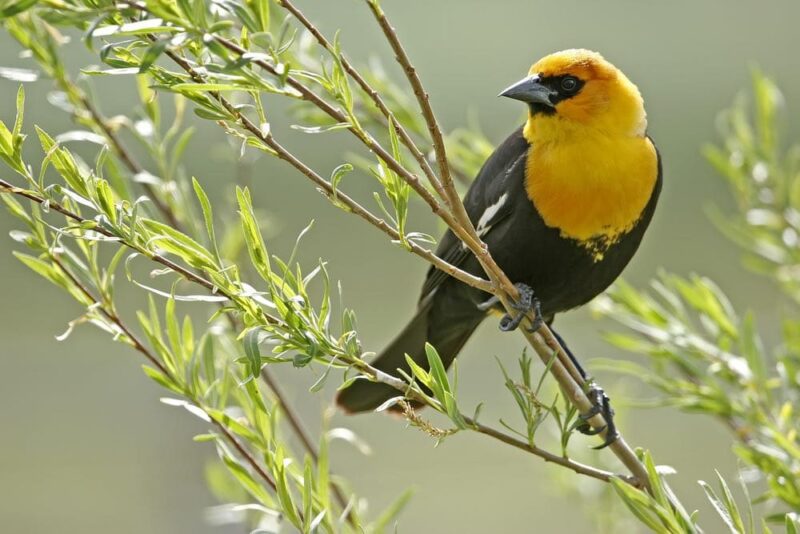
| Scientific Name | Xanthocephalus xanthocephalus |
| Wingspan | 5–17.3 inches |
| Size | 3–10.2 inches |
Appearing in central and eastern Washington during the breeding season, the Yellow-Headed Blackbird make their home in wetland areas. Nestlings are sometimes required to swim short distances due to the species’ habit of building their nests in reeds hanging over the water.
Their black feathering gives the males a typical blackbird appearance, while the bold white stripe on their wings and bright yellow head draw your eye. In comparison, the females are much less noticeable, with only small patches of yellow on their face and chin.

Rare Visitors
12. Baltimore Oriole

| Scientific Name | Icterus galbula |
| Wingspan | 9.1–11.8 inches |
| Size | 6.7–7.5 inches |
Although the Baltimore Oriole is more prevalent in the eastern states, they have been seen in Washington in recent years, particularly in Seattle and Asotin. Due to their rarity in Washington, they’re believed to be an accidental addition to the wildlife in the state.
Recognized by the stark contrast between the black back feathers and reddish-orange undercarriage of the males, the Baltimore Oriole makes their home in residential areas and parks. They earned their name from the heraldic crest of the Baltimore family in England that bears the same orange and black colors.
13. Common Grackle
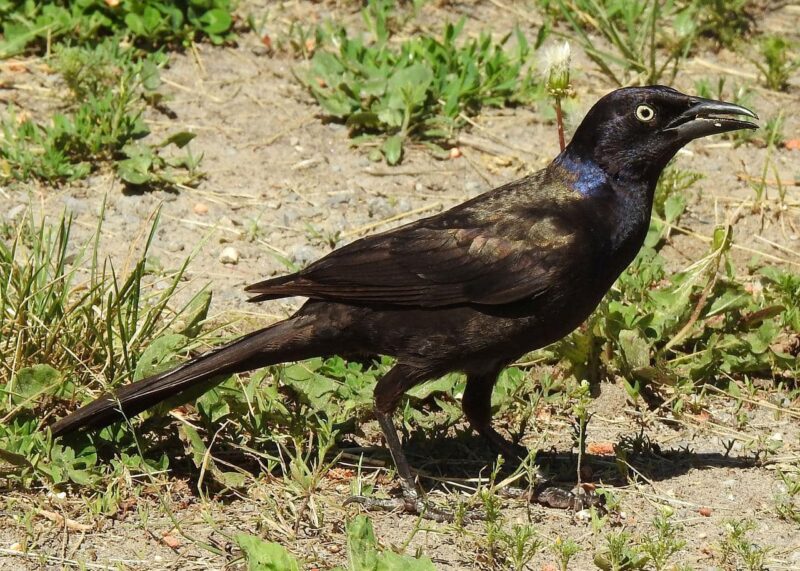
| Scientific Name | Quiscalus quiscula |
| Wingspan | 2–18.1 inches |
| Size | 0–13.4 inches |
With the same beady yellow eye as the Brewer’s Blackbird, the Common Grackle isn’t a common sight in Washington BECAUSE they’re not a species native to the state. Preferring to stay on the eastern coast of the U.S.A. and to breed in the central states, the Common Grackle is considered an accidental addition to Washington, but they have been spotted recently in Pasco.
Considered endangered by the IUCN, the Common Grackle has a metallic plumage with black, purple, gold, and green feathers. The females are a deep purple-tinted brown, with the same beady yellow eye as the males.
14. Great-Tailed Grackle

| Scientific Name | Quiscalus mexicanus |
| Wingspan | 9–22.8 inches |
| Size | 15–18.1 inches |
Spotted in Fall City in the last few years, the Great-Tailed Grackle is actually native to Central America and the southwestern and central states of the U.S.A. Despite their rarity in Washington, though, the males are the quintessential blackbird, with deep black plumage and iridescent purple feathers. The females have black backs with brown heads and undercarriages.
In winter, they roost in winter flocks that can be made up of thousands of birds and can reach numbers of half a million in the Rio Grande Valley sugarcane fields in Texas.
15. Hooded Oriole
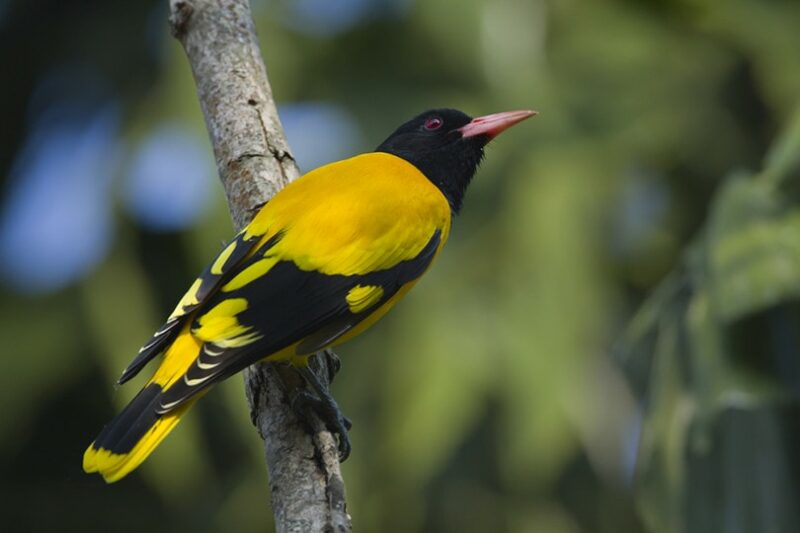
| Scientific Name | Icterus cucullatus |
| Wingspan | 1–11 inches |
| Size | 1–7.9 inches |
The Hooded Oriole is native to Mexico, Central America, and only a few places in California, Texas, Arizona, Nevada, and New Mexico. While these reddish-orange blackbirds were spotted in Bay Center, Washington, they’re rare and probably accidental visitors to the state.
Similar to other orioles, the Hooded Oriole has bright yellow breast feathers and can be recognized by their yellow hoods and black face markings. The contrast between their bright and dark feathers gives them a dashing appearance.
16. Orchard Oriole
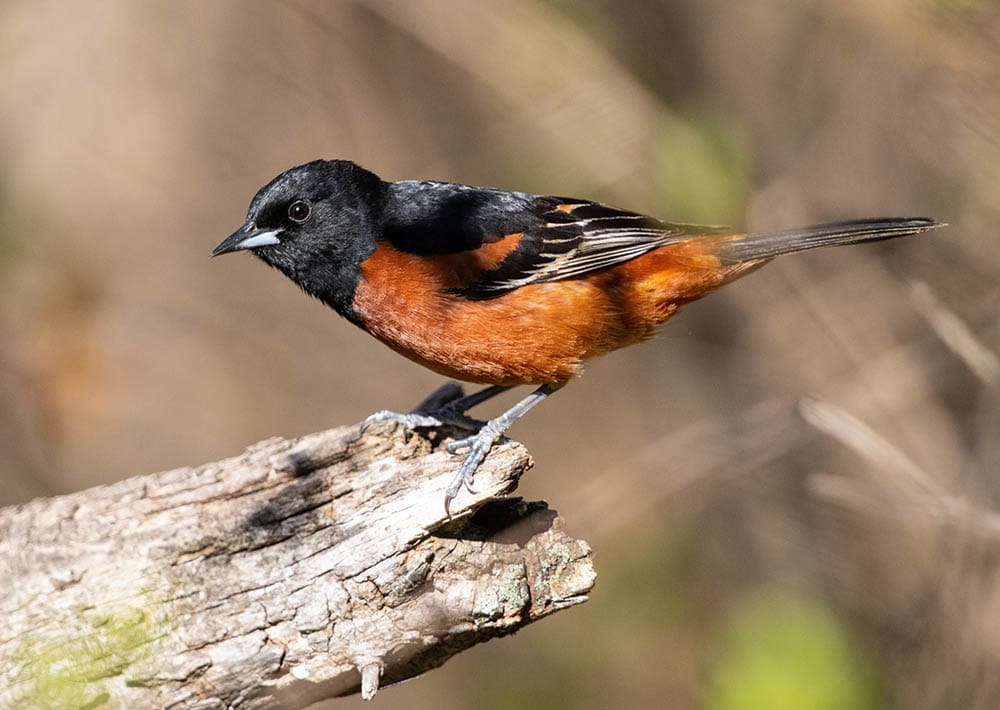
| Scientific Name | Icterus spurius |
| Wingspan | 8 inches |
| Size | 9–7.1 inches |
Although the male Orchard Oriole trades the reddish-orange coloring of other orioles for a deep reddish brown, their colors are no less striking. The females in comparison are brighter, with similar yellow coloring to their fellow orioles.
As another accidental visitor to Washington, the Orchard Oriole is native to Central America and the western and central states. They favor open woodlands and are the smallest oriole in North America. Similar to the Bullock’s Oriole, the Orchard Oriole often visits hummingbird feeders to drink the sugar water.
17. Rusty Blackbird
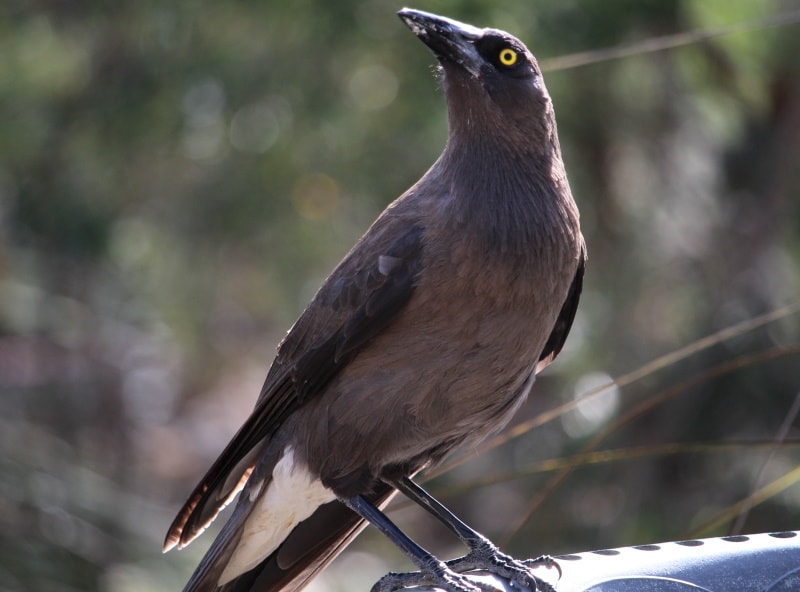
| Scientific Name | Euphagus carolinus |
| Wingspan | 6 inches |
| Size | 3–9.8 inches |
A rare find in Washington State, the Rusty Blackbird is one of the many blackbird species that range in appearance. While the breeding males are completely black, they have rust-colored feathering throughout their plumage during winter. The females are light brown with darker patches and pale eyes.
More commonly found in the eastern states and Canada, the Rusty Blackbird occasionally appears in Washington during the winter months. They mostly feast on insects but have been known to eat robins, sparrows, and other birds.
18. Scott’s Oriole

| Scientific Name | Icterus parisorum |
| Wingspan | 6 inches |
| Size | 9.1 inches |
With their last appearance in Washington in 1980, the Scott’s Oriole isn’t one that you’re likely to find in recent years except in parts of California, New Mexico, Utah, Arizona, Texas, and Mexico. They’ve never been native to Washington, but their appearance in the 1980s and distinctive black feathers have earned them a place on this list all the same.
Like other orioles, the Scott’s Oriole shares the same contrasting black-and-yellow plumage. The females have a subtler green-tinted yellow hue with brown wings.

Final Thoughts
When you first think about black birds, it’s easy to assume that all birds with black feathers fall into the family. However, black birds can be some of the most vibrantly colored birds around. Some of the most distinctive black birds — like crows, ravens, and the European Starling — aren’t part of the blackbird family at all.
We hope that this list has helped you identify a few of the birds that you can find in Washington, whether they’re blackbirds or only have black feathers.
Featured Image Credit: Jo Kleeb, Shutterstock
Table of Contents
About the Author Robert Sparks
Robert’s obsession with all things optical started early in life, when his optician father would bring home prototypes for Robert to play with. Nowadays, Robert is dedicated to helping others find the right optics for their needs. His hobbies include astronomy, astrophysics, and model building. Originally from Newark, NJ, he resides in Santa Fe, New Mexico, where the nighttime skies are filled with glittering stars.
Related Articles:
Monocular vs Telescope: Differences Explained (With Pictures)
10 Types of Hummingbirds in Arkansas (With Pictures)
8 Types of Hummingbirds in Nebraska (With Pictures)
5 Types of Hummingbirds in Idaho (With Pictures)
3 Types of Hummingbirds in Mississippi (With Pictures)
8 Types of Hummingbirds in Kansas (With Pictures)
5 Types of Hummingbirds in West Virginia (With Pictures)
5 Types of Hummingbirds in Ohio (With Pictures)
